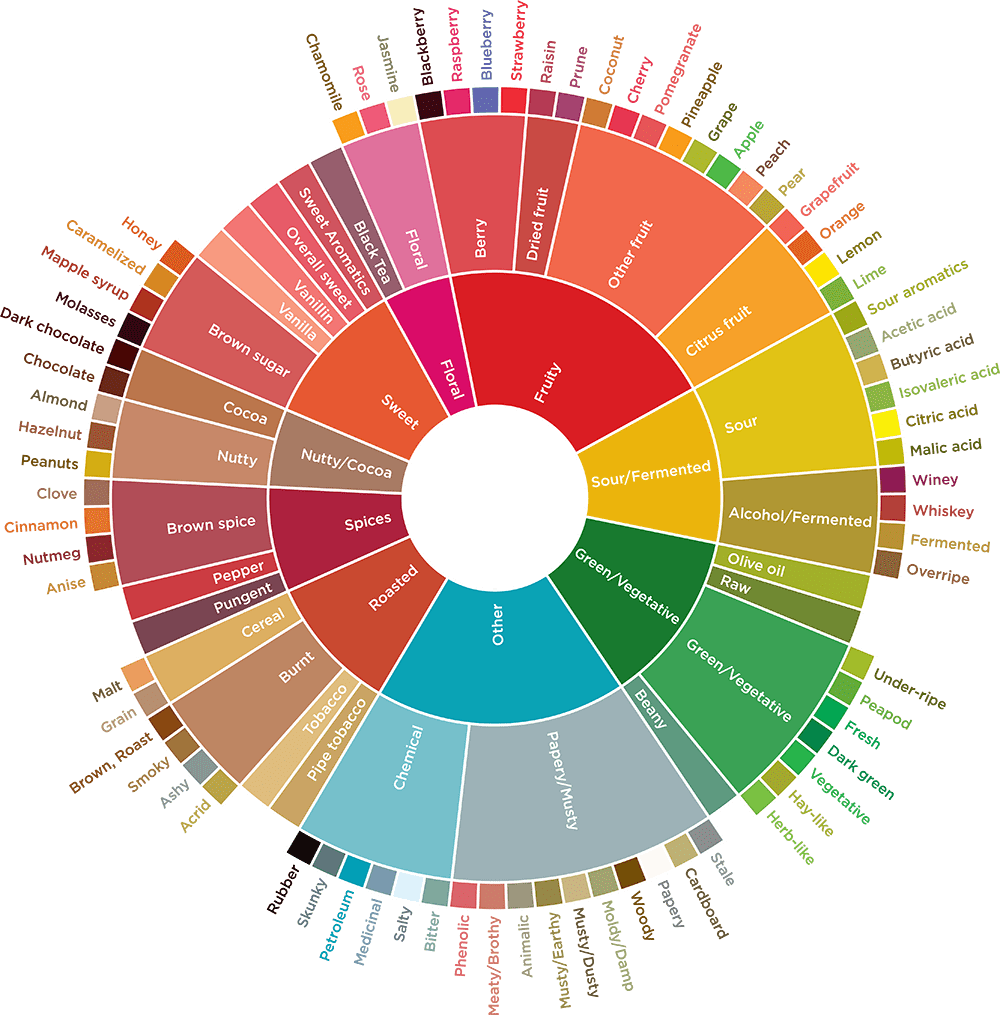Exploring Coffee Flavor Profiles: From Fruity to Nutty, Uncover Every Note

Affiliate Disclosure: As an Amazon Associate, I earn from qualifying purchases. This post may also contain other affiliate links, meaning I may earn a small commission if you buy through them, at no extra cost to you. Your support helps keep this site running and allows me to continue sharing great content. Thank you!
What makes a cup of coffee sing with bright citrus notes or embrace you with deep, nutty undertones? Coffee flavor profiles span a wide range, shaped by everything from the bean’s origin and growing conditions to the roasting and brewing methods. Each cup offers a unique taste experience, connecting you to the region it comes from and the care taken in its preparation.
Exploring these diverse coffee flavor profiles helps elevate your appreciation for every sip. Whether you prefer the fruity brightness of an Ethiopian roast or the rich, chocolatey warmth of a Colombian blend, understanding the factors influencing flavor will deepen your coffee journey.
In this post, we’ll uncover the essential elements that shape coffee’s flavor, helping you better understand and enjoy the subtleties in each cup.
Next, we’ll examine the key elements that shape flavor profiles and explain why coffee tastes the way it does.
Breaking Down Coffee Flavor Profiles
Every cup of coffee has a unique personality, shaped by various factors that influence its flavor. These profiles help you understand why some coffees taste fruity while others have rich, chocolatey undertones. Understanding these profiles adds depth to your coffee experience and enables you to make more informed choices when selecting beans.
What Defines Coffee Flavor Profiles?
Several key factors influence the taste profile of coffee, each contributing to the distinct experience in your cup.
Bean Variety
Different species of coffee beans—primarily Arabica and Robusta—bring distinct flavors to the table. Arabica beans, known for their smooth and often sweeter profile, tend to feature fruitier, floral notes. Robusta beans, on the other hand, are stronger and more bitter, often carrying earthy or nutty flavors.
Growing Altitude
Altitude plays a major role in the flavor complexity of coffee. Beans grown at higher altitudes, such as those from Ethiopia or Kenya, typically produce bright, vibrant flavors with more pronounced acidity. Lower-altitude beans, common in regions like Brazil, offer more subdued, earthy, or nutty tones.
Processing Method
How coffee beans are processed after harvesting greatly impacts their final taste.
- Washed Process: Washed coffee beans tend to have cleaner, brighter acidity. This method involves removing the coffee cherry’s fruit before the beans are dried, resulting in a crisp and clear flavor profile. The washed process is known for bringing out the bean’s natural acidity and enhancing clarity.
- Natural Process: In contrast, natural processed beans are dried with the fruit still attached. This method typically leads to sweeter, fruitier flavors, as the sugars in the fruit influence the beans during drying. Coffees processed this way often have more body and complexity in their taste.
- Honey Process: The honey process strikes a balance between the two. In this method, part of the coffee cherry’s mucilage—the sticky layer surrounding the bean—is left on during drying. This process results in coffee with the bright acidity of washed beans and the fruity sweetness of natural processed beans. It also creates a medium body with hints of both sweetness and complexity.
Roast Level
The degree to which coffee beans are roasted can either enhance or mask certain flavors.
- Lighter Roasts tend to preserve the bean’s natural flavors, often fruity or floral.
- Medium Roasts create a balance between acidity and sweetness.
- Darker Roasts develop richer, deeper flavors like chocolate or caramel, sometimes with a smoky or bitter edge.
Acidity and Body
While flavor profiles offer a rich variety of tastes, two other key components—acidity and body—also shape your coffee experience. Acidity adds brightness and liveliness to your cup, while body refers to its texture or weight. These elements enhance the overall balance of flavors.
To further explore acidity and body and how they influence coffee, check out my post on Analyzing Coffee Acidity and Body.
Connecting the Dots
Understanding these factors helps explain why coffee from different regions has distinct tastes. This knowledge allows you to choose beans that match your preferences, whether you prefer bright, fruity flavors or deeper, earthier ones.

Exploring Common Coffee Flavor Categories
The diversity of coffee taste profiles is truly remarkable, ranging from sweet and fruity to earthy and spicy. These categories can help you pinpoint flavors that resonate with your palate, guiding your coffee choices. Here’s a breakdown of the most common flavor categories you’ll encounter.
Fruity: A Symphony of Berries, Citrus, and Tropical Delights
Fruity coffees are known for their bright and refreshing qualities. Tangy berries like strawberry or raspberry, along with vibrant citrus tones such as lemon and orange, often shine through. Certain coffees even offer exotic tropical nuances like mango or pineapple. These notes are especially common in beans from African regions, like Ethiopia, where high-altitude growing conditions enhance their brightness.
Floral: Elegant Jasmine and Lavender Undertones
Floral notes, such as jasmine or lavender, can add a delicate complexity to your coffee. These nuances often come from lighter roasts of beans grown in high-altitude regions. Floral tones are common in African coffees, particularly in Ethiopian and Kenyan varieties.
Nutty: The Comforting Embrace of Hazelnut and Almond
Nutty undertones add warmth and richness, making your coffee feel comforting and satisfying. You might recognize notes of hazelnut, almond, or even peanut in coffees from Latin America, where growing conditions lend themselves to these comforting profiles. Nutty undertones are often accompanied by hints of caramel, adding a subtle sweetness to your brew.
Chocolatey: Indulgent Dark Chocolate and Creamy Milk Chocolate
Chocolatey coffees are crowd-pleasers. Whether it’s the deep, dark richness of cocoa or the creamy smoothness of milk chocolate, these flavors often appear in medium or dark roasts. Coffee from Central and South America, like Colombia and Brazil, is well-known for its chocolate and nutty profiles.
Spicy: A Touch of Cinnamon and Clove
Spicy notes in coffee can add a warming layer of flavor, similar to the comforting spices found in chai. Cinnamon, clove, and even nutmeg are common spicy undertones. Earthy and spicy profiles dominate many Asian coffees, particularly those from Indonesia.
Earthy: The Rustic Charm of Mushroom and Forest Floor
Earthy flavors evoke images of nature, the smell of wet soil, fresh mushrooms, or even tobacco. These deep, grounding notes are characteristic of coffees from Indonesia, particularly Sumatra, and can provide a bold and rustic character to your cup.
Regions play a vital role in shaping the flavors of your coffee. From fruity African beans to earthy Asian blends, geography leaves a mark on every cup.
Curious to apply what you’ve learned? Watch this guide to master the art of tasting coffee and unlock its flavor profiles.
Regional Influence on Coffee Flavor: A World Tour
Coffee is truly a global experience, with each region adding its own unique twist to the flavors we enjoy. From fruity African beans to earthy Indonesian brews, understanding how geography shapes flavor helps us appreciate the diversity in every cup.
Exploring the Enchanting Flavors of Africa
Africa is often hailed as the birthplace of coffee, and the flavors from this continent are vibrant and complex. Beans from regions like Ethiopia and Kenya are known for their fruity and floral profiles, often featuring bright acidity and notes of berries or citrus.
- Ethiopia: Ethiopian coffees, especially those from high-altitude areas like Yirgacheffe, are renowned for their floral aromas and fruity notes. Expect flavors like jasmine, blueberry, and lemon with a lively, refreshing acidity.
- Kenya: Kenyan beans are equally bold but offer a different spectrum of flavors. These coffees often have a wine-like acidity and notes of blackcurrant or red berries, making them stand out in the specialty coffee market.
Unearthing the Complexity of Asian Coffee
Asian coffee regions, particularly Indonesia and Vietnam, produce some of the most earthy and full-bodied coffees. These flavors are shaped by the tropical climates and unique processing methods used in the region.
- Indonesia: Indonesian coffees, particularly from Sumatra, are known for bold, earthy flavors like tobacco, mushrooms, and spice. The beans typically have low acidity and a full body, making them perfect for those who enjoy deep, rustic flavors.
- Vietnam: While often associated with robusta beans, Vietnam’s coffee culture offers rich, chocolatey, and nutty flavors. These coffees are often full-bodied with a hint of bitterness, making them ideal for strong, concentrated brews like Vietnamese iced coffee.
Discovering the Richness of Latin American Coffees
Latin America produces a significant portion of the world’s coffee, with countries like Brazil, Colombia, and Guatemala leading the way. The flavors from this region are often well-balanced, offering a smooth mix of sweetness and acidity.
- Brazil: As the world’s largest coffee producer, Brazil delivers beans with nutty and chocolatey undertones, often featuring a smooth, mild acidity. These coffees have a full body and are commonly used in espresso blends.
- Colombia: Colombian coffee is beloved for its balance of sweetness, acidity, and body. With notes of chocolate, caramel, and nuts, Colombian brews offer a smooth, approachable cup, making them a favorite among many coffee enthusiasts.
The Influence of Central American Coffee
Countries like Costa Rica and Guatemala are known for producing complex and bright coffees. The volcanic soils and high altitudes in this region contribute to the distinct flavor profiles found in their beans.
- Costa Rica: Known for its crisp, clean flavors, Costa Rican coffee often has a balance of fruitiness and chocolatey notes, with a bright acidity that lingers on the palate.
- Guatemala: Guatemalan beans are often full-bodied with flavors of cocoa, nuts, and sometimes spice. The rich, volcanic soil where these beans are grown adds to their complexity and depth.

Ethiopia

Sumatra Indonesia

Brazil

Costa Rica
After understanding how regions shape flavor, let’s focus on how the roasting process enhances and transforms these flavors.
Roasting Levels: Crafting the Perfect Flavor
Roasting is a critical step in shaping coffee’s flavor, transforming green beans into the rich, aromatic coffee we know and love. The roast level greatly influences the taste, aroma, and even the body of the coffee. Let’s break down how different roasting levels bring out unique characteristics.
Light Roasts: Preserving the Bean’s True Character
Light roasts are known for their bright acidity and fruity or floral notes. The bean’s natural characteristics are more pronounced because the roasting process hasn’t overshadowed them with heavier flavors.
- Flavor Profile: Light roasts reveal bright fruitiness with a crisp acidity. You may also taste hints of floral notes or even light herbal undertones.
- Best For: Coffees from high-altitude regions like Ethiopia or Kenya, where complex, fruity profiles shine.
- Appearance: Light roasts are pale brown with little to no oil on the surface of the beans.
Medium Roasts: Finding Balance
Medium roasts offer a compromise between preserving the bean’s origin flavors and developing a fuller body. They balance acidity and sweetness, creating a well-rounded cup of coffee.
- Flavor Profile: Caramel, chocolate, and nutty notes become more prominent as sweetness intensifies in medium roasts. The acidity is less intense compared to light roasts, but still present.
- Best For: Latin American beans, such as those from Colombia or Costa Rica, where balanced sweetness and medium body are preferred.
- Appearance: Medium roasts are slightly darker brown, still with minimal oil.
Dark Roasts: Bold, Rich, and Intense
Dark roasts undergo a longer roasting process, which breaks down much of the bean’s original flavors and replaces them with deep, bold flavors developed during the roast.
- Flavor Profile: Dark chocolate, caramelized sugar, and smoky notes commonly emerge in these roasts. Acidity is significantly reduced, replaced by heavier, bitter notes.
- Best For: Coffees from Brazil or Sumatra, where the beans have a robust, full-bodied nature that complements darker roasts.
- Appearance: Dark brown to almost black, with a shiny, oily surface.
For a quick comparison of how each roast level impacts flavor, here’s an overview of their profiles, ideal beans, and appearance:
| Roast Level | Flavor Profile | Best For | Appearance |
| Light | Fruity, floral, crisp acidity | High-altitude beans (Ethiopia) | Light brown, no oil |
| Medium | Balanced, sweet, caramel, nutty | Latin American beans (Colombia) | Medium brown, minimal oil |
| Dark | Bold, smoky, dark chocolate, low acidity | Robust beans (Brazil, Sumatra) | Dark brown to black, oily surface |

With an understanding of how roasting influences flavor, we can now explore how brewing methods bring out different aspects of these flavors, allowing you to fine-tune your coffee experience.
Brewing Methods: Extracting the Best Flavors
The way you brew your coffee significantly impacts the nuances that emerge in your cup. Each brewing method highlights different aspects of a coffee’s profile, from the brightness of light roasts to the depth of dark roasts. Understanding how each method affects flavor helps you make the most of your coffee experience.
French Press: Bold and Full-Bodied
The French Press uses full immersion brewing, where coffee grounds are steeped in hot water for several minutes before being filtered. This method results in a rich, heavy cup with a pronounced body and mouthfeel.
- Flavor Profile: French Press brewing draws out full-bodied, bold coffee, with strong earthy and chocolate undertones. The longer steeping time also extracts more of the coffee’s natural oils, contributing to its heavier texture.
- Best For: Darker roasts and coffees with deep, robust flavors, such as those from Sumatra or Brazil.
Pour-Over: Clean and Nuanced
The pour-over method uses gravity to draw water through the coffee grounds, resulting in a clean and crisp cup. This brewing technique highlights the subtler flavors of coffee, such as fruity and floral notes, while minimizing bitterness.
- Flavor Profile: Pour-over techniques deliver bright, clean coffee with pronounced acidity. Fruity and floral notes are often more prominent, making it ideal for light to medium roasts.
- Best For: High-altitude beans, such as those from Ethiopia or Kenya, where complex and delicate flavors shine.
Espresso: Intense and Concentrated
Espresso uses high pressure to force water through the finely ground coffee, creating a small, concentrated shot of intense flavor. Due to the fast extraction process, espresso preserves many of the bean’s original flavors while adding a crema layer, enhancing texture and taste.
- Flavor Profile: Rich, intense flavors with a creamy texture. Expect chocolatey or nutty notes in darker roasts and subtle long-brewing accents in lighter ones.
- Best For: Beans from Brazil, Colombia, or blends that balance boldness and complexity.
Cold Brew: Smooth and Low Acidity
Cold brew involves steeping coffee grounds in cold water for an extended period, usually 12 to 24 hours. This slow extraction process produces a smoother, less acidic coffee with naturally sweet flavors.
- Flavor Profile: Smooth, sweet, and mellow with low acidity. The long-brewing time brings out chocolate and caramel notes while minimizing any bitterness.
- Best For: Medium to dark roasts with sweet or chocolatey profiles, like those from Central America or Indonesia.
If you’re looking for a quick comparison of how each brewing method affects flavor, here’s an overview of the key differences:
| Brewing Method | Flavor Profile | Best For |
| French Press | Bold, full-bodied, earthy, chocolatey | Darker roasts (Sumatra, Brazil) |
| Pour-Over | Clean, bright, fruity, floral | Light to medium roasts (Ethiopia, Kenya) |
| Espresso | Rich, intense, creamy, chocolatey | Balanced blends, dark roasts (Brazil, Colombia) |
| Cold Brew | Smooth, sweet, low acidity, chocolatey | Medium to dark roasts (Central America, Indonesia) |




Unlocking the Flavors of Coffee: Your Journey Awaits
Understanding coffee flavor profiles is the key to unlocking a richer and more enjoyable coffee experience. Whether you’re drawn to the fruity notes of an Ethiopian Yirgacheffe or a Brazilian dark roast’s bold, chocolatey undertones, knowing what shapes these taste profiles transforms every cup into an adventure.
Experimenting with different beans, roast levels, and brewing methods allows you to explore the full spectrum of flavors coffee has to offer. As you explore coffee’s diverse taste profiles, your palate will sharpen, helping you discover the perfect brew for your tastes.
Now that you’ve gained a deeper understanding of coffee flavors, it’s time to put your knowledge into practice. Try beans from different regions, play around with various brewing methods, and discover which profiles resonate most with you.
What notes are you picking up in your cup? Let’s explore them together. Drop your thoughts or questions below to keep the conversation brewing. What’s your favorite coffee region or brewing method? Let us know in the comments!

I help coffee lovers experience the rich stories, origins, and luxury of high-end coffee. At Aroma Expeditions, I share my passion for sustainable sourcing, ethical beans, and the art behind every pour.
Let’s turn your daily brew into an adventure worth savoring.
Coffee is such a beloved drink across the world, and I completely agree about the delightful aroma and taste—it’s truly a treat for the senses! There’s nothing quite like a good cup of coffee in the morning to start the day off right. I especially love exploring the wide variety of flavors available. From fruity to nutty, the choices are endless, and there’s always something new to discover!
I love that you’re experimenting with different flavors—it’s such a fun part of the coffee journey!
Personally, I find that medium roasts bring out some really interesting flavor notes, especially when using a pour-over method. Do you have any favorite flavor profiles you keep coming back to? We’d be curious to know what makes them stand out for you.
This article does a fantastic job of breaking down the various elements that shape coffee flavor profiles. I’ve always enjoyed coffee but didn’t realize just how much factors like altitude and processing methods can influence taste. The explanation of fruity versus chocolatey tones really helped me understand why I prefer certain beans over others, especially when choosing between Ethiopian and Colombian roasts. The section on roast levels also made me rethink how I brew my coffee at home. I might experiment more with medium roasts to see if I can bring out more balanced flavors. Thanks for such an insightful post!
Thank you so much for your kind words and for sharing your experience!
It’s fantastic to hear how the breakdown of different coffee elements resonated with you, especially when comparing Ethiopian and Colombian roasts.
Experimenting with medium roasts sounds like an exciting journey to discover more balanced flavors. If you find any favorite techniques, feel free to share—our community would love to learn from your experience!
Do you have a favorite brewing method that pairs well with the medium roast you plan to experiment with?